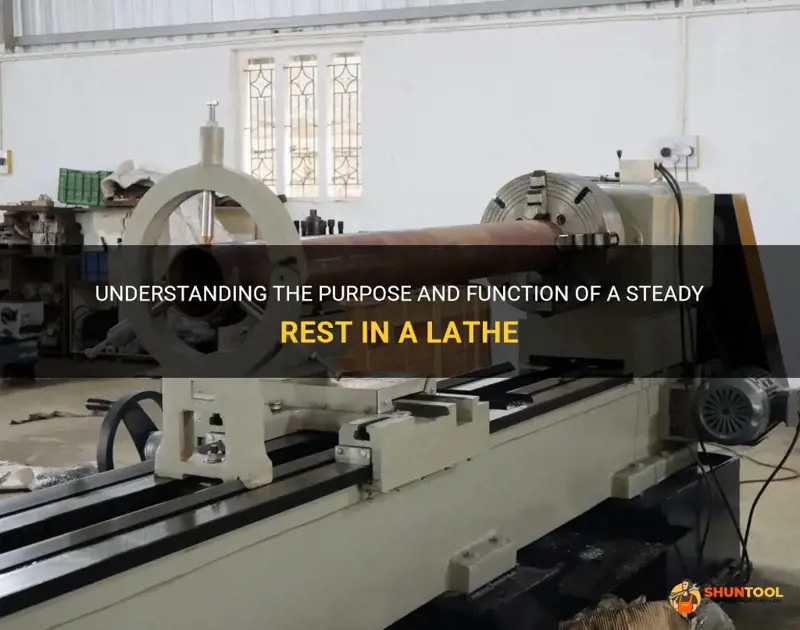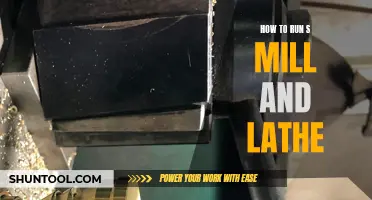
Imagine a lathe, whirling and shaping a piece of metal with precision and finesse. Now imagine a device that supports and stabilizes this piece of metal, ensuring consistent accuracy and reducing vibrations. This device is called a steady rest. Steady rests play a crucial role in the world of lathe operations, providing much-needed support and stability, and allowing craftsmen to create intricate and flawless pieces. In this article, we will delve into the fascinating world of steady rests, exploring their functionalities, benefits, and various types. So, join us on this journey as we uncover the secrets of steady rests and their integral role in the art of machining.
| Characteristic | Value |
|---|---|
| Purpose | Supports the workpiece during turning operations |
| Construction | Typically a cylindrical or rectangular body with one or more adjustable jaws |
| Types | Fixed steady rest, traveling steady rest, follower steady rest |
| Adjustability | Jaws can be moved closer or further apart to accommodate different workpiece diameters |
| Support | Provides additional support to prevent deflection and vibration during machining |
| Clamping | Jaws are clamped onto the workpiece to hold it securely in place |
| Centering | Helps to center the workpiece accurately |
| Compatibility | Can be used with various types of lathe machines |
| Material | Made of cast iron or steel for strength and rigidity |
| Lubrication | Should be properly lubricated to reduce friction and wear |
| Size | Available in different sizes to accommodate different workpiece diameters |
| Application | Used in turning operations where the workpiece is long and slender |
| Mounting | Attached to the lathe bed or carriage using bolts or clamps |
What You'll Learn
- What is the purpose of a steady rest in a lathe?
- How does a steady rest work in supporting a workpiece?
- What are the advantages of using a steady rest in lathe operations?
- What types of materials are suitable for use with a steady rest in a lathe?
- Are there any limitations or considerations to keep in mind when using a steady rest in a lathe?

What is the purpose of a steady rest in a lathe?
A steady rest is an important tool used in lathes to support and stabilize long and thin workpieces during the machining process. It is essentially a support device that can be adjusted to fit different diameters and lengths of workpieces. The purpose of a steady rest is to prevent bending, vibration, and deflection of the workpiece, ensuring accurate and precise machining.
When it comes to machining long and slender workpieces, such as shafts or bars, the force exerted by the cutting tool can cause the workpiece to bend or vibrate. This can lead to inaccuracies in machining and poor surface finishes. The steady rest, therefore, acts as a support system that counteracts these forces and helps maintain the workpiece in a fixed position.
One of the main benefits of using a steady rest is the reduction of deflection. When a workpiece is subjected to cutting forces, it tends to flex or deflect, causing dimensional inaccuracies. By using a steady rest, the workpiece is held firmly in place, preventing deflection and ensuring that the desired dimensions and tolerances are maintained.
In addition to reducing deflection, a steady rest also helps to minimize vibration. When a workpiece is rotating at high speeds, even a small amount of vibration can cause significant problems. Vibrations can affect the accuracy and surface quality of the machined part. By providing additional support and stability, the steady rest ensures that vibrations are dampened, resulting in better machining results.
The design of a steady rest typically consists of three adjustable jaws that can be tightened around the workpiece. These jaws are usually lined with a soft material, such as brass or nylon, to avoid marring or damaging the surface of the workpiece. The jaws can be adjusted to fit different diameters, allowing the steady rest to be used with a variety of workpieces.
To use a steady rest, it is important to position it correctly on the lathe bed. The jaws should be adjusted to fit snugly around the workpiece, but not so tight as to cause deformation. The adjustment should be done carefully, ensuring that all three jaws provide equal support and contact with the workpiece.
Once the steady rest is properly positioned, it can be tightened using the appropriate clamping mechanism. It is important to secure the steady rest firmly to prevent any movement during machining. This will ensure maximum support and stability for the workpiece.
In conclusion, the purpose of a steady rest in a lathe is to provide additional support and stability for long and slender workpieces. By reducing deflection and minimizing vibration, a steady rest ensures accurate and precise machining. It is an essential tool for machinists, enabling them to produce high-quality parts with tight tolerances.
Understanding the Meanings and Uses of Lathe Sizes: A Comprehensive Guide
You may want to see also

How does a steady rest work in supporting a workpiece?
A steady rest is a mechanical device used in machining operations to support a workpiece that is long, slender, or otherwise prone to distortion or vibration when subjected to cutting forces. It is commonly used in lathe operations, as well as in milling and grinding operations. The primary function of a steady rest is to provide additional support to the workpiece, preventing deflection, chatter, or vibration, which may result in inaccurate machining and surface finish.
The basic design of a steady rest consists of three main components: a base, a body, and three adjustable jaws. The base attaches directly to the machine bed and provides a solid foundation for the steady rest. The body houses the jaws and allows for vertical adjustment, while the jaws are responsible for clamping the workpiece securely.
When a workpiece is mounted between the jaws of a steady rest, the jaws are adjusted to apply a moderate amount of pressure to the workpiece. This pressure should be sufficient to hold the workpiece in place without deforming or damaging it. The jaws are typically lined with a soft material, such as brass or nylon, to prevent marring or scratching of the workpiece's surface.
By supporting the workpiece at multiple points along its length, the steady rest helps to distribute cutting forces evenly, reducing the likelihood of deflection or vibration. The jaws are typically positioned just ahead of the cutting tool, allowing for the workpiece to be machined accurately and producing a smooth and precise surface finish. The steady rest is often adjustable horizontally, allowing for precise alignment and positioning of the workpiece.
In addition to providing support, a steady rest can also be used to control the alignment and concentricity of the workpiece. This is particularly important when machining long or slender shafts, where even a slight misalignment can result in significant inaccuracies. By adjusting the jaws of the steady rest, the operator can ensure that the workpiece is properly centered and aligned with the machine's axis of rotation.
To use a steady rest effectively, it is important to follow a few key steps. First, the workpiece should be inserted into the jaws of the steady rest, ensuring that it is securely clamped in place. Next, the jaws should be adjusted to apply the appropriate amount of pressure, taking care not to over-tighten and deform the workpiece. It is also important to regularly inspect and clean the steady rest, removing any debris or chips that may have accumulated during machining.
In conclusion, a steady rest is an essential tool in machining operations for supporting a workpiece that is prone to deflection or vibration. By providing additional support and controlling alignment, it helps to ensure accurate and precise machining, resulting in high-quality parts and improved surface finish. Proper use of a steady rest, including careful adjustment and regular maintenance, is crucial for achieving optimal results.
Mastering the Art of Lathe Contact Lens Production: A Comprehensive Guide
You may want to see also

What are the advantages of using a steady rest in lathe operations?
A steady rest is a highly useful tool in lathe operations. It is designed to support long, slender workpieces and prevent them from flexing or vibrating during machining. This is especially important when working with materials that have a tendency to deform under stress, such as thin-walled pipes or delicate shafts. Using a steady rest offers several advantages that can greatly improve the quality and accuracy of lathe operations.
The primary advantage of using a steady rest is the increased stability it provides to the workpiece. When turning long and slender objects, they tend to flex or vibrate under the force of the cutting tool. This can result in uneven cuts and poor surface finish. By supporting the workpiece with a steady rest, it remains rigid and stable throughout the machining process, ensuring consistent and accurate results.
Another advantage of using a steady rest is the reduction of chatter during machining. Chatter is a common problem in lathe operations and is caused by the interaction between the cutting tool and the workpiece. It can lead to poor surface finish, inaccuracies in dimensions, and even tool breakage. The steady rest acts as a damping mechanism, absorbing vibrations and reducing the occurrence of chatter. This results in smoother cuts, improved surface finish, and overall better machining performance.
In addition to stability and chatter reduction, a steady rest also allows for the machining of long workpieces without the need for additional support. When working with exceptionally long objects, it may be necessary to use additional supports or fixtures to prevent sagging or bending. However, with the use of a steady rest, the workpiece is fully supported along its length, eliminating the need for extra support mechanisms. This not only saves time and effort, but also simplifies the machining process and reduces the risk of errors.
Furthermore, a steady rest can help prevent workpiece distortion caused by cutting forces. When cutting materials that have low rigidity or high thermal expansion properties, such as certain plastics or thin-walled tubes, the cutting forces can cause the workpiece to deform. This can result in inaccurate dimensions and poor part quality. By applying support to the workpiece through a steady rest, the cutting forces are distributed more evenly, minimizing workpiece distortion and ensuring dimensional accuracy.
To use a steady rest effectively in lathe operations, follow these steps:
- Adjust the steady rest to match the diameter of the workpiece. Most steady rests have adjustable jaws that can be moved in or out to accommodate different sizes of workpieces. Ensure that the jaws are securely tightened around the workpiece to provide maximum support.
- Position the steady rest along the length of the workpiece where support is needed. The steady rest should be placed close to the cutting tool, but not too close that it interferes with the machining process. A general rule is to position the steady rest at a distance of about three times the diameter of the workpiece.
- Secure the steady rest to the lathe bed using the provided clamping mechanism. Make sure that the steady rest is firmly attached and does not move during machining.
- Start the lathe and begin the machining process. The steady rest will provide support and stability to the workpiece, allowing for accurate cutting and improved surface finish.
In summary, using a steady rest in lathe operations offers several advantages, including increased stability, reduced chatter, simplified machining of long workpieces, and prevention of workpiece distortion. By following the proper steps for setup and usage, a steady rest can greatly improve the quality and accuracy of lathe operations.
Does Poplar Work Well on Lathes? Here's What You Need to Know
You may want to see also

What types of materials are suitable for use with a steady rest in a lathe?
A steady rest is a mechanical device used in lathes to provide support and stability to long and slender workpieces during machining. It helps prevent bending and vibration, resulting in improved surface finish and dimensional accuracy. However, not all materials are suitable for use with a steady rest. Certain factors need to be taken into consideration when selecting materials for use with a steady rest. In this article, we will explore these factors and provide some examples of suitable materials.
The first factor to consider when selecting materials for use with a steady rest is the size and shape of the workpiece. Steady rests are typically used with long and slender workpieces such as shafts, rods, and pipes. These workpieces are prone to bending and vibration during machining, and the steady rest helps counteract these forces. Therefore, materials that are long and slender in shape are most suitable for use with a steady rest.
Another important factor to consider is the tensile strength of the material. Steady rests exert pressure on the workpiece to provide support and stability. If the material is too weak or brittle, it may not be able to withstand the pressure exerted by the steady rest. Therefore, materials with high tensile strength, such as steel and iron alloys, are ideal for use with a steady rest.
Additionally, the machinability of the material should also be taken into consideration. Some materials are more difficult to machine than others due to their hardness or brittleness. If a material is too hard or brittle, it may cause excessive tool wear or breakage during machining. Therefore, materials that are easy to machine, such as aluminum and brass, are often preferred for use with a steady rest.
Finally, the surface finish requirements of the workpiece should be considered when selecting materials for use with a steady rest. Some materials, such as stainless steel, require more precise machining techniques to achieve the desired surface finish. If the material is too difficult to machine accurately, it may not be suitable for use with a steady rest. On the other hand, materials that are easier to machine, like mild steel or copper, may be better suited for use with a steady rest.
In conclusion, selecting the right material for use with a steady rest in a lathe is crucial for ensuring optimal machining results. Factors such as the size and shape of the workpiece, tensile strength, machinability, and surface finish requirements should be taken into consideration. Steel and iron alloys are often preferred for their high tensile strength, while aluminum and brass are selected for their ease of machining. Ultimately, the choice of material will depend on the specific requirements of the machining operation and the desired outcome.
Understanding the Auto Measurement Caliper on a Brake Lathe
You may want to see also

Are there any limitations or considerations to keep in mind when using a steady rest in a lathe?
When using a lathe, a steady rest is an essential tool that is used to support and stabilize long and thin workpieces. It is commonly used when turning materials such as rods, pipes, or shafts. The steady rest is typically mounted on the lathe bed and is positioned to provide additional support for the workpiece, reducing the risk of vibration and ensuring a more accurate and smoother turning process. While using a steady rest offers many advantages, there are also some limitations and considerations that need to be kept in mind.
One of the main limitations of using a steady rest is the reduction in the maximum diameter of the workpiece that can be turned. The presence of the steady rest restricts the movement of the material and requires additional clearance. This means that the diameter of the workpiece should be smaller than the capacity of the steady rest. It is crucial to check the specifications of the steady rest and ensure it can accommodate the desired workpiece before starting the turning process.
Another consideration when using a steady rest is the potential for marking or damaging the surface of the workpiece. As the steady rest contacts and supports the material, there is a risk of creating marks or scratches. To minimize this risk, it is important to ensure that the steady rest is clean and free from debris or rough edges that could damage the workpiece. Additionally, using a steady rest with soft pads or inserts can help protect the surface of the material.
Proper positioning of the steady rest is crucial to ensure optimal support and stability. The steady rest should be positioned as close as possible to the area being turned, while still allowing clearance for the cutting tool. This helps to minimize the unsupported length of the workpiece, reducing the risk of deflection and vibration. It is important to adjust the position of the steady rest as needed throughout the turning process to maintain optimal support.
When using a steady rest, it is essential to monitor the temperature of the workpiece. Extended contact with the steady rest can generate heat, which can lead to thermal expansion and distortion of the material. Regularly checking the temperature of the workpiece and allowing it to cool if necessary can help prevent any detrimental effects.
Lastly, it is important to note that using a steady rest may not always be necessary. For shorter or thicker workpieces that have sufficient rigidity, a steady rest may not provide significant benefits and can even increase the risk of vibration. It is important to assess the specific requirements of each turning project and determine if using a steady rest is appropriate.
In conclusion, using a steady rest in a lathe offers numerous advantages in terms of support and stability. However, it is important to consider the limitations and potential risks associated with the use of a steady rest. Checking the specifications of the steady rest, minimizing surface damage, positioning it correctly, monitoring the temperature of the workpiece, and evaluating the need for a steady rest in each turning project are key considerations to keep in mind. By understanding and addressing these factors, one can ensure a successful and efficient turning process.
Understanding the Function and Purpose of a Hydraulic Lathe
You may want to see also
Frequently asked questions
A steady rest is a device used in lathe machines to support long and slender workpieces during machining operations. It consists of a frame or housing that is clamped onto the lathe bed, and adjustable jaws or fingers that can be positioned to support the workpiece and prevent it from flexing or vibrating during turning.
When machining long and slender workpieces, such as shafts or rods, they tend to flex or vibrate due to the cutting forces applied during turning. This can result in poor surface finish, dimensional inaccuracies, or even damage to the workpiece. A steady rest provides additional support and stability to the workpiece, allowing for more precise and accurate machining.
A steady rest typically has three jaws or fingers that are positioned around the workpiece. These jaws can be adjusted to apply a gentle and even pressure on the workpiece to prevent it from deflecting under cutting forces. The jaws can also be repositioned along the length of the steady rest to provide support at different points along the workpiece.
Yes, there are different types of steady rests available depending on the size and type of workpiece being machined. Some steady rests are designed for smaller diameter workpieces, while others are capable of supporting larger and heavier workpieces. There are also self-centering steady rests that automatically adjust to the diameter of the workpiece, as well as manual steady rests that require manual adjustment of the jaws.







